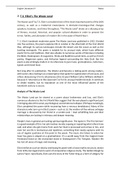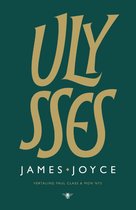English Literature IV Notes
7. T.S. Elliot’s The Waste Land
The Waste Land” by T.S. Eliot is considered one of the most important poems of the 20th
century, as well as a modernist masterpiece. A dramatic monologue that changes
speakers, locations, and times throughout, “The Waste Land” draws on a dizzying array
of literary, musical, historical, and popular cultural allusions in order to present the
terror, futility, and alienation of modern life in the wake of World War I.
T. S. Eliot’s landmark modernist poem The Waste Land was published in 1922. Divided
into five sections, the poem explores life in London in the aftermath of the First World
War, although its various landscapes include the desert and the ocean as well as the
bustling metropolis. The poem is notable for its unusual style, which fuses different
poetic forms and traditions. Eliot also alludes to numerous works of literature including
the Bible, Shakespeare, St Augustine, Hindu and Buddhist sacred texts, as well as French
poetry, Wagnerian opera, and Arthurian legend surrounding the Holy Grail. But the
poem is also strikingly modern in its references to jazz music, gramophones, motorcars,
typists and tinned food.
Not long after its publication, The Waste Land became a talking-point among readers,
with some critics hailing it as a masterpiece that spoke for a generation of lost souls, and
others denouncing it for its allusiveness (the US poet William Carlos Williams disliked it
because it ‘returned us to the classroom’) or for its unusual modernist style. It continues
to divide readers, but its reputation as one of the most influential poems of the
twentieth century is secure.
Analysis of The Waste Land
The Waste Land can be viewed as a poem about brokenness and loss, and Eliot’s
numerous allusions to the First World War suggest that the war played a significant part
in bringing about this social, psychological, and emotional collapse. (Perhaps revealingly,
Eliot completed the poem while recovering from a nervous breakdown.) Many of the
characters who turn up in Eliot’s poem – such as Lil, the mother-of-five whose unhappy
marriage is discussed by her friend in a London pub – lead unfulfilling lives and their
relationships are lacking in intimacy and deeper meaning.
People’s lives in general are lacking spiritual significance. The typist in ‘The Fire Sermon’
is a good example of this: her job involves merely copying or repeating what others have
said, and when she gets home from work her food is processed and comes in tins, and
even her sex life is mechanical and repetitive, something Eliot neatly captures with his
use of regular quatrains at this point in the poem. The music she listens to when her
lover has gone is played on a gramophone: it’s a world away from the magical music
Ferdinand heard on the enchanted island in Shakespeare’s The Tempest. Modern life
has lost all sense of magic and meaning.
Eliot reinforces such an idea by overlaying his poem with a loose mythic structure, drawn
from Arthurian legend and a work of comparative religious study, The Golden Bough by
James Frazer. Specifically, Eliot uses the story of the Fisher King as a form of allegory for
,English Literature IV Notes
the modern world. The Fisher King has been wounded in the groin, and his wound has
also affected the kingdom over which he rules. The once fertile and abundant soil has
ceased to yield crops; the land has become a waste land.
The cure for this spiritual sickness which plagues the king and his land is the Holy Grail,
but only those who are pure of heart will find the Grail (the cup that, according to
Christian legend, caught Jesus’ blood at the Crucifixion). Is anyone in the modern world
of The Waste Land up to such a task? The poem’s references to the Buddhist Fire
Sermon suggest that before we will become worthy of salvation, we must first learn to
curb our worldly desires and passions in order to attain spiritual enlightenment.
The Waste Land begins with a reference to a ‘heap of broken images’ and ends with a
collage of quotations taken from various poetic traditions, as well as a snippet from the
nursery rhyme ‘London Bridge is falling down’. Art, literature, oral and written culture –
civilisation itself – seem to be under threat. Can we do anything other than shore up the
ruins? The poem ends on an ambiguous note, with the triple repetition of the Sanskrit
word ‘Shantih’, which Eliot translates as ‘the peace which passeth understanding’. Has
such peace finally been achieved, or is this merely wishful thinking? The breakdown of
the poem into a confused medley of semi-coherent quotations implies that after the
war, such peace remains a far-off dream.
Key themes
Theme Description
Fragmentation Enacted through the poem’s use of free verse (especially in ‘What the Thunder
and decay Said’) and its references to ‘fragments’ and ‘broken images’
Sex and Seen in the conversation in the London pub at the end of ‘A Game of Chess’, the
relationships section describing the typist and ‘young man carbuncular’ in ‘The Fire Sermon’,
and the Earl of Leicester and Queen Elizabeth I (the ‘Virgin Queen’), among
others
War See the poem’s references to an ‘archduke’ (suggesting Archduke Franz
Ferdinand, whose assassination caused the outbreak of WWI), rats, dead men
and their bones, demobbed soldiers, and possible shell-shock victims (the man
in the middle section of ‘A Game of Chess’)
• Critic, Poet, conservative (politically and religious)
• He wanted to reproduce the collapse of Western civilization
➢ Not only physical destruction, but also spiritual destruction
➢ Looking for the salvation and savior
• Title: sterility of Western (not only English) man
• The poem is a collage of history
➢ Related to conception of literature
,English Literature IV Notes
• There is a salvation, but only for the ones who want to.
• Develops the theme of death and rebirth
➢ Typical Christian and other myths theme
➢ Rebirth: Baptism, Overflooding of Nile (Nile and Ganges vs. Thames)
➢ From Ritual to Romance by Jessie Weston and The Golden Bough by James
Frazer
• The Fisher King is the sort of basis for the poem
• The Grail Legend
➢ The search for the grail is not only physical, it is also or above all spiritual
➢ Chapel Perilous: get over your fears
• Other influences: Ulysses (1922) by Joyce
➢ Also mixes myth and modern daily life
• The myth is the element that unifies past and present
• Different myths and different voices
➢ Idea of collective experience
• Unity through recurrent images: the 4 elements
➢ Earth: the title itself
➢ Air: fetid, corrupted
➢ Water: spiritual rebirth
➢ Fire: sexual desire, although it could mean spiritual revelation like in
Buddha’s The Fire Sermon (but it is used as ironic element in the poem,
revelation is never reached).
Structure: 5 sections in the Wasteland
1. The Burial of the Dead
2. A Game of Chess
3. The Fire Sermon
4. Death by Water
5. What the Thunder Said
1st section: The Burial of the Dead
• “April is the cruelest month”
➢ In Chaucer it is the time of spiritual rebirth, because it is a good time for
pilgrimage
➢ But for Eliot it is the cruelest month, because there is no one actually taking
up the spiritual search, they prefer to be spiritually dead
• Episodes:
1-7: the Dead
, English Literature IV Notes
8-18: Memories
19-29: Desert of the Old Testament and The Waste Land, the prophet is talking,
but no one is listening
• The German sentences from Wagner’s Tristan and Isolde: the idea of dying
because of love
➢ Liebestod: it is such a big love it is only to be in another life or world
➢ The Waste Landers’ relationship vs. Tristan and Isolde
• Introduction of Madame Sosostris, the prophet the fortune teller
• The Tempest by Shakespeare
• Irony: The real prophets are speaking, unheard, in the desert and the people
turn to false prophets, who cannot even find her own spiritual way and she
warns from Death by Water, which is actually the image of rebirth
• An unreal city: London
➢ Because of the fog
➢ Reference to the bell, pass of time, like in Mrs. Dalloway
13/02/2013
2nd section: A Game of Chess
• Comparison of this relationship, spiritually empty with this great lovestory of
Anthony and Cleopatra
➢ They look pathetic, it’s ironic
• She has a painting of the brutal myth of Philomel’s rape and her
metamorphosis into a Nightingale
➢ This shows lack of taste and it is ironic
• Indication of neurosis, probably a depiction of Eliot’s wife (l. 111)
• Lines: 139-160
➢ Working class character talking
➢ They’re in a pub
➢ 2 women in a pub talking about Albert
➢ This Albert comes back from war, he wants to have fun, but she can’t
because of abortive pills
➢ Physical decay, she’s only 31, but looks very old
➢ Sex as something empty, sterile, with no product
➢ They’re in a pub: ‘Hurry up it’s time’
• Lines: 169-172
➢ Hamlet referencing
➢ Ophelia and Cleopatra and Philomel: Women who couldn’t live without
their true love and died
➢ Completely different from the Waste Landers’ relationships
➢ Ironic





